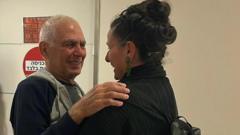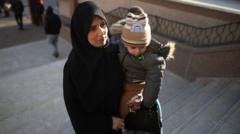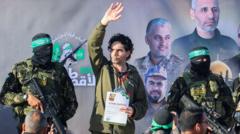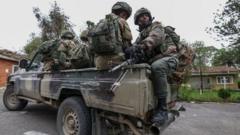As Gaza emerges from a prolonged conflict, rescue workers estimate that over 10,000 bodies may still be buried under rubble. Though a ceasefire is in place, the devastation is palpable, and humanitarian aid is slowly being reintroduced amid pressing challenges.
Gaza Faces Harrowing Recovery: Rescuers Confront Scale of a Tragedy
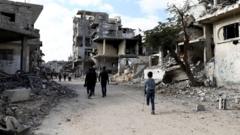
Gaza Faces Harrowing Recovery: Rescuers Confront Scale of a Tragedy
In the wake of a ceasefire, the people of Gaza begin to grapple with the overwhelming destruction and loss.
In the aftermath of a ceasefire that marked the first full day of peace in Gaza on Monday, the onus fell upon rescue workers and civilians to confront the staggering scale of destruction left in the wake of 15 months of conflict. Gaza's Civil Defence agency, the principal emergency response service, revealed its harrowing estimate that over 10,000 bodies could still lie beneath the debris, with spokesman Mahmoud Basal expressing hope to recover them within 100 days, though such efforts are hampered by a shortage of essential equipment, including bulldozers.
Recent images from Gaza unveiled scenes of total devastation, particularly in the northern regions overwhelmed by Israeli bombings. The United Nations had previously reported that around 60% of Gaza’s structures faced damage or destruction as a grim result of ongoing hostilities. While the cessation of airstrikes instigated celebrations, the reality for many Gazans is one of poverty and tragedy. Over two million residents currently find themselves homeless, entirely dependent on humanitarian assistance for survival. The flow of aid began immediately post-ceasefire, with the UN reporting at least 630 lorries entering Gaza by day’s end, a figure that swelled to 915 lorries the following day, marking the highest influx since the war's onset.
Sam Rose, acting director of UNRWA, emphasized the urgency beyond food supplies; the rebuilding of infrastructure, healthcare, and community support is critical: "The trauma and suffering endured over 16 months is not just a statistic. It speaks of many lives needing restoration."
In Israel, a press conference celebrated the release of three hostages as the Israeli families expressed bittersweet excitement. While Mandy Damari reported her daughter Emily's recovering spirits, the heartbreak lingers for other families still missing loved ones. Furthermore, an agreement may lead to a release of 30 more hostages as a reciprocal gesture for approximately 1,800 Palestinians in Israeli jails within the next 40 days.
The Gaza Health Ministry currently estimates that over 46,900 individuals lost their lives during the tumult, with the majority identified as women and children. A UK-led report in The Lancet suggested that the death toll may be significantly higher than official figures reflect.
The Civil Defence agency noted a staggering 48% of its personnel have been either killed, injured, or captured, alongside extensive damage to their operational vehicles and facilities. Amid the cessation of airstrikes, the strenuous task of recovery must continue. Abdullah Al-Majdalawi, a young Civil Defence worker, lamented, "In every street, there are dead. Please, come help. My family is buried under the rubble."
The challenge continues for young Gazans like Malaak Kasab, recently displaced, who mourns lost family members still trapped beneath ruins. "It is unlivable," she remarked, describing her damaged home. As some displaced individuals risk journeys to their former residences, the Israeli military cautions against approaching their installations.
With fears of the ceasefire collapsing before its completion, the UN Secretary-General, Antonio Guterres, heralded the pause as a "ray of hope" that must be realized while simultaneously warning of escalating tensions in the occupied West Bank amid rising Israeli incursions and threats of annexation.
As Gaza grapples with profound tragedy, the pathway to gradual recovery and reconciliation seems daunting, and the necessity for humanitarian aid and support remains paramount.
Recent images from Gaza unveiled scenes of total devastation, particularly in the northern regions overwhelmed by Israeli bombings. The United Nations had previously reported that around 60% of Gaza’s structures faced damage or destruction as a grim result of ongoing hostilities. While the cessation of airstrikes instigated celebrations, the reality for many Gazans is one of poverty and tragedy. Over two million residents currently find themselves homeless, entirely dependent on humanitarian assistance for survival. The flow of aid began immediately post-ceasefire, with the UN reporting at least 630 lorries entering Gaza by day’s end, a figure that swelled to 915 lorries the following day, marking the highest influx since the war's onset.
Sam Rose, acting director of UNRWA, emphasized the urgency beyond food supplies; the rebuilding of infrastructure, healthcare, and community support is critical: "The trauma and suffering endured over 16 months is not just a statistic. It speaks of many lives needing restoration."
In Israel, a press conference celebrated the release of three hostages as the Israeli families expressed bittersweet excitement. While Mandy Damari reported her daughter Emily's recovering spirits, the heartbreak lingers for other families still missing loved ones. Furthermore, an agreement may lead to a release of 30 more hostages as a reciprocal gesture for approximately 1,800 Palestinians in Israeli jails within the next 40 days.
The Gaza Health Ministry currently estimates that over 46,900 individuals lost their lives during the tumult, with the majority identified as women and children. A UK-led report in The Lancet suggested that the death toll may be significantly higher than official figures reflect.
The Civil Defence agency noted a staggering 48% of its personnel have been either killed, injured, or captured, alongside extensive damage to their operational vehicles and facilities. Amid the cessation of airstrikes, the strenuous task of recovery must continue. Abdullah Al-Majdalawi, a young Civil Defence worker, lamented, "In every street, there are dead. Please, come help. My family is buried under the rubble."
The challenge continues for young Gazans like Malaak Kasab, recently displaced, who mourns lost family members still trapped beneath ruins. "It is unlivable," she remarked, describing her damaged home. As some displaced individuals risk journeys to their former residences, the Israeli military cautions against approaching their installations.
With fears of the ceasefire collapsing before its completion, the UN Secretary-General, Antonio Guterres, heralded the pause as a "ray of hope" that must be realized while simultaneously warning of escalating tensions in the occupied West Bank amid rising Israeli incursions and threats of annexation.
As Gaza grapples with profound tragedy, the pathway to gradual recovery and reconciliation seems daunting, and the necessity for humanitarian aid and support remains paramount.

